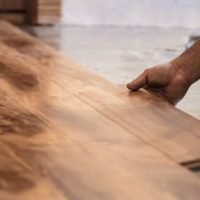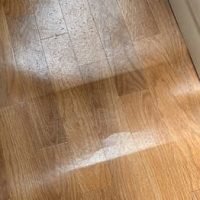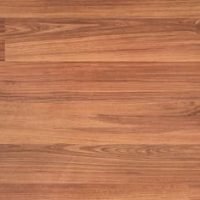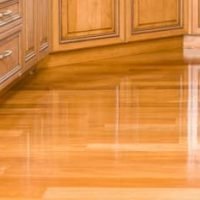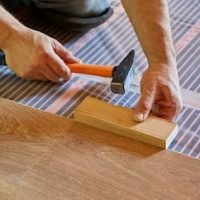Hardwood floor installation gives a luxurious look to any place. It is also most popular among homeowners due to its stability and durability. Further, hardwood floors are found in various varieties.
If you properly install the solid hardwood flooring, it is never damaged or ruins. There are many features of installing process to take care of it.
Everyone wants to know that,
Do I need underlayment for hardwood flooring?
The most one is underlayment to underlay the wood. If you are new, you don’t know about it.
Don’t worry, in this article you can find all the information regarding underlayment for hardwood floors.
What Is Underlayment?
It is just a layer of any material that is placed between the subfloor and hardwood floor. There are many purposes of installing it like avoiding moisture, proper and smooth surface, sound reduction, and many more.
Soma hardwood floors may come with attached underlayment, to need to use extra. But, some have not. So, you need a separate underlayment to attach underlay it.
Which Type Of Material Is Used For It?
The most asking question is if we need to use them,
What is best and safe for expensive hardwood flooring?
Some of these are
- Felt
- Rubber
- Cork
- Foam
All these are considered best for hardwood flooring, laminate, and vinyl flooring. Below is the explanation of each of the following
- Felt
Felt is the most popular underlayment for engineered floating hardwood. With moisture-resistance and sound reduction qualities, it delivers what the floor wants.
1. Quiet walk QW100plus Hardwood Felt Underlayment Review
The recycled material will help to absorb sound and keep it from transferring to another room. Plus, the moisture barrier feature protects the hardwood floors over concrete. The moisture vapor may pass the plywood or subfloor. But, the felt paper stop it to reach the upper surface.
Furthermore, it doesn’t contain ant volatile organic elements or off-gases material. So, it is environment-friendly and never affects the air quality.
The felt underneath the floors, glued floors and hardwood floors are highly recommended to secure the hardwood subfloor and hardwood flooring.
Sometimes, the heavyweight and high pressure causes the brake of subfloor joists. If you have this thick underlayment it provides protection.
Pros of Quiet walk
- Warm the hardwoods floor
- Designed for all floors as you need
- Highly durable and versatile
- Adds comfort and barrier
- Dampens the sound according to need
Cons of Quiewalk
- The higher density unable to provide enough sound reduction
The product rating is 4.8 out of 5
You can pick heavier layers of dark felt for extra protection, sound assimilation, and dampness resistance.
Thick layers of dark felt likewise give additional padding, expanding the solace of your room. Makers make got a handle on the underlayment of reused materials, making this a harmless ecosystem choice for your home.
Notwithstanding felt is somewhat straightforward contrasted with another underlayment. While higher-thickness felt gives additional assurance.
- Foam
Foam is an easy to install and affordable method. It is a more comfortable option for securing, sound reduction, and moisture barrier. The important feature is that these barriers reduce the reduction between floor and subfloor. The wood flooring naturally expands with season changes and produces echoing sounds. For such conditions, foam is primarily a choice for the kitchen and basement.
- Cork
If you are attempting to try out minor blemishes, the cork is adaptable and will fit equally between the subfloor and the solid hardwood flooring. It likewise assists with protecting against cold and heat and is water safe. It’s not waterproof, yet you can purchase a stopper with a dampness hindrance.
Cork has incredible sound-decrease properties. It is even utilized in music studios to go out foundation babble from finished recordings.
One final advantage of cork is for those enduring sensitivities: it has antagonistic to microbial and anti-fungal properties. Put this for second stories.
- Rubber
Rubber has already natural waterproof features. So, it automatically protects moisture. People recommend rubbers for a flat wood flooring surface for best and high-standard underlayment. But, it is expensive and not affordable for anyone.
Consider it first, if you need expensive sound reduction underlayment.
Why We Need An Underlayment For Hardwood Floors?
Well, it is not necessary to install underlayment during the installation of the floor. Usually, underlayment is installed or used for different installation purposes. One of the most right reasons is floor stability, sound dampens, subflooring imperfection, to avoid tripping problems. The floating floor needs underlayment to avoid squeaking and creaking.
Furthermore, it reduces the echoes of noise, TVs, and other voices.
The hardwood flooring surface is not perfectly fine to walk because of coldness. So, the underlayment gives cushioning without using carpets or rugs.
- Subfloor Imperfection
A subfloor is one of the primary needs for any flooring establishment. At the point when you nail or paste wood floor onto a lopsided surface, the completed solid wood floor will likewise be lopsided.
Not exclusively does this represent a stumbling risk, it additionally leaves your excellent wood floor looking not exactly awesome. Significant defects ought to continuously be fixed before introducing floors.
However, minor plunges and breaks don’t need a total redesign. If you can track down a subfloor underlayment sufficiently thick to make up for little, lopsided regions, it would be more affordable and quicker to utilize that than to destroy the entire flooring.
Do I Need An Underlayment For Hardwood Flooring-Final Thoughts
If you install hardwood directly on the subfloor, they cause many problems. The underlayment makes the hard flooring secure for possible time to get better results. The nailing on uneven surface damage the flooring.
Some flooring already has underlayment. But if not, you need to underlay the best barrier on the subfloor and plywood before installation of engineered wood floors. The concrete floating does not need to resist vapor. So, you need underlayment installing under laminate and wood floors
If you need long-lasting flooring, you need to use flooring underlayment between plywood subfloor and laminate flooring wood floors. The underlay paper may also provide comfort, cushion, and warmth in contrast to temperature.
Contents

